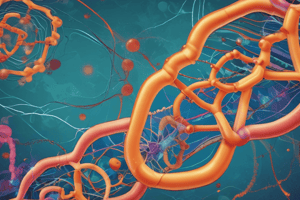Podcast
Questions and Answers
What is the function of the poly A signal during transcription in eukaryotes?
What is the function of the poly A signal during transcription in eukaryotes?
- It attracts proteins that cut RNA from the polymerase. (correct)
- It signals the termination of RNA synthesis.
- It modifies the RNA for splicing.
- It initiates the synthesis of RNA.
Which of the following correctly describes the process of transcription elongation?
Which of the following correctly describes the process of transcription elongation?
- It can occur at a rate of 40 nucleotides per second. (correct)
- It proceeds in a 3’→5’ direction.
- It involves the removal of introns.
- It results in the synthesis of the template strand.
What is the role of spliceosomes in eukaryotic gene expression?
What is the role of spliceosomes in eukaryotic gene expression?
- They facilitate the splicing of introns from pre-mRNA. (correct)
- They protect RNA from degradation.
- They translate mRNA into proteins.
- They synthesize mRNA from DNA.
How does alternative splicing contribute to protein diversity?
How does alternative splicing contribute to protein diversity?
Which of the following statements best describes the genetic code?
Which of the following statements best describes the genetic code?
Flashcards
Codon
Codon
A sequence of three nucleotides that specifies a particular amino acid or a stop signal during protein synthesis.
Template strand
Template strand
The strand of DNA that serves as a template for RNA synthesis during transcription.
Transcription
Transcription
The process by which the genetic information in DNA is copied into a complementary RNA sequence.
Introns
Introns
Signup and view all the flashcards
Translation
Translation
Signup and view all the flashcards
Study Notes
Gene Expression Overview
- Biology 135A, Gene Expression (Ch. 17)
- Course Instructor: Rajab
- The process of turning genetic information into functional gene products (proteins)
- Involves two major steps: transcription and translation
Outline of Gene Expression
- Discovery of genes and the genetic code
- Transcription
- RNA modification
- Translation
Introduction to Transcription and Translation
- DNA → RNA → Protein
- Transcription occurs in the nucleus, generating messenger RNA (mRNA)
- mRNA moves to the cytoplasm for translation
- Translation takes place on ribosomes in the cytoplasm, producing polypeptides
The Genetic Code
- Triplet code: 64 codons
- Template and non-template (coding) DNA strands
- mRNA is synthesized and translated in the 5' → 3' direction
Genetic Code Characteristics
- 61 codons for amino acids
- 3 stop codons
- Degenerate code: multiple codons can code for the same amino acid
- Universal code: the same mRNA codons specify the same amino acids in all organisms
Eukaryotic RNA Processing
- Capping and tailing: protection and initiation
- Export from the nucleus
- Splicing: removal of introns, linking exons together
- Spliceosome and spliceosome components for splicing process
Alternative Splicing
- One gene can code for multiple proteins, depending on which exons are included in the final mRNA
Translation-Overview
- Major players: mRNA, tRNA, amino acids, aminoacyl tRNA synthetases, ribosomes, polypeptide
- mRNA is decoded to produce polypeptide chains
tRNA Structure and Function
- Single-stranded
- Acceptor stem for amino acid attachment
- Anticodon for complementary base pairing with mRNA
Aminoacyl-tRNA Synthetases
- Enzymes that attach amino acids to their corresponding tRNA molecules
Ribosomes Structure and Function
- Small and large subunits
- P, A, E sites for tRNA binding and polypeptide synthesis
Translation Initiation
- Initiator tRNA, mRNA binding site, small ribosomal subunit, large ribosomal subunit, start codon
Translation Elongation
- Codon recognition, peptide bond formation, translocation
- mRNA moves in the 5' to 3' direction
Translation Termination
- Stop codons (UAG, UAA, or UGA), release factor
- Polypeptide released from the ribosome
Protein Folding and Targeting
- Proteins fold as they are made
- Signal peptide targets proteins to specific locations
- Signal recognition particle (SRP) recognizes specific signal sequence and halts protein synthesis until the protein reaches the ER
- Translocation complex into the endoplasmic reticulum (ER)
- Polypeptides folded into correct conformation
- Protein destination decided by signal peptide
- Ribosomes either free or bound to ER
Polyribosomes
- Multiple ribosomes translate the same mRNA simultaneously
Coupled Transcription/Translation in Bacteria
- Simultaneous transcription and translation in bacteria occurs in the cytoplasm.
- The ribosomes attach to the mRNA as it is being transcribed.
COVID mRNA Vaccines
- mRNA vaccines contain instructions to make a viral protein
- Cells produce the protein, prompting an immune response
- No exposure to the whole virus, so no symptoms
Studying That Suits You
Use AI to generate personalized quizzes and flashcards to suit your learning preferences.
Related Documents
Description
Explore the essential processes of gene expression in this quiz based on Biology 135A, Chapter 17. Delve into transcription, translation, and the genetic code, and understand how genetic information is transformed into proteins. Test your knowledge on the principles governing these vital biological processes.




